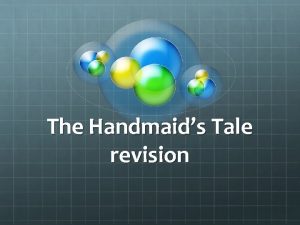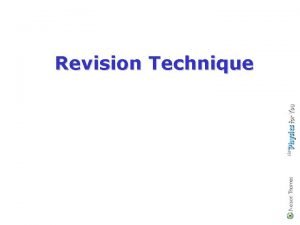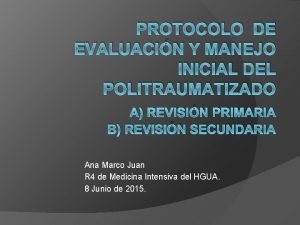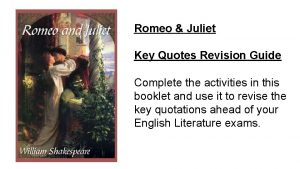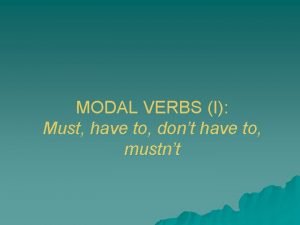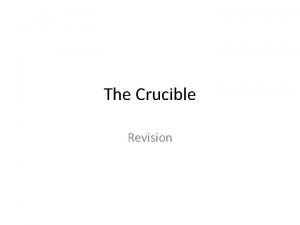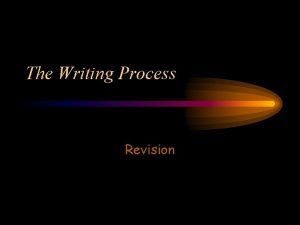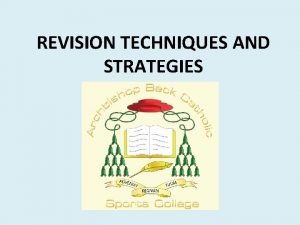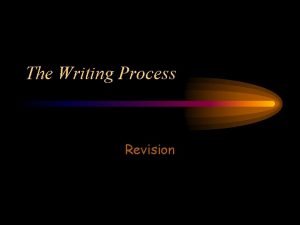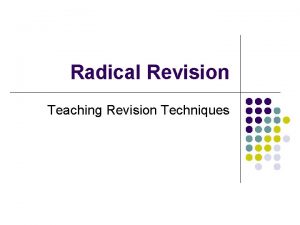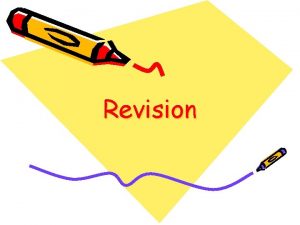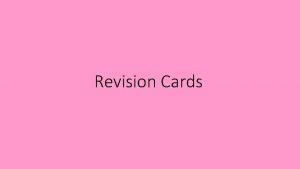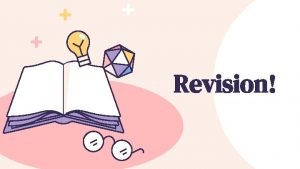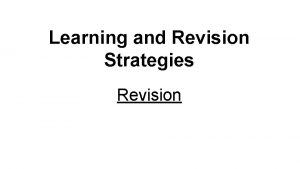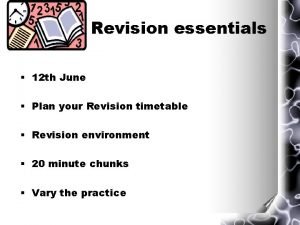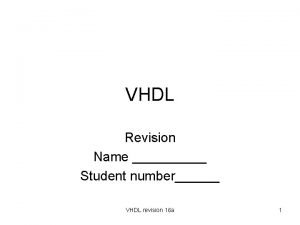Revision Today 01 What is revision 02 03


















- Slides: 18

Revision!

Today, 01 What is revision? 02 03 04 How do we revise? What does revision look like? Why do we revise? And other good questions

01 Revision: what is it?

Revision is a crucial part of the writing process. It deals with the more conceptual changes in our writing. It’s the process of rearranging, adding or removing lines, sentences, paragraphs, or words; juicing up our images; recalibrating our form; changing or adding a title; and even more things depending on the writing itself! This is different than editing, which concerns itself with the easier stuff: grammar, punctuation, capitalization.

Revision is… • Cutting words, sentences, or maybe entire paragraphs • Condensing a long segment into a shorter version • Adding content • Switching synonyms • Rearranging words, sentences, or paragraphs • Rewriting a chunk of text • Changing your structure, style of writing, formality level, or another characteristic • …and sometimes , starting over from scratch. Revision isn’t… • Cutting just one word total • Moving just one sentence • Adding very little, or just in one spot • Changing the font, margins, or other formatting to make the document “look” different • Only editing grammar (and not making changes to the content ) • Leaving a vast majority of the document exactly the way it was. It does not count as revision unless it is a true makeover – making a LOT of VISIBLE changes to the CONTENT to make the writing better!

Think of revision like a makeover. 1. Scissors: Cut words (or entire sentences/paragraphs!) that aren’t actually needed. 2. Brush: Add detail, facts, description, or other clarity where needed. 3. Upgrade: Swap out existing words for better ones and replace them with different synonyms, OR completely different ideas. 4. Shape: Rearrange your current draft. Move sentences within paragraphs, reorder the existing paragraphs, or make even bigger structure changes that will improve the flow or clarity.

Or, think STAR S substitute T take out A add R rearrange

Things to look for when we revise Diction Imagery Line breaks Syntax Beginnings and Endings Assignment Requirements

Diction The words we choose to use. Every word in our writing is it’s own little decision — was it the best decision possible? Be Verbs Dead Words Also known as fluff words, these words we can’t picture. Good, bad and ALL variations of these words are dead words. If you tell me the weather is “good, ” I have no idea what that looks like. The most boring verb. Think of your Spanish conjugations — “be” verbs are English’s versions of ser and estar: am, are, is, was, and were. We can’t always get rid of all of them, but we can get rid of most — this often involves re-arranging your sentence structure. Had / got / made We never need these — these are easy words to replace with more vivid verbs.

Imagery is language used by poets, novelists and other writers to create images in the mind of the reader. Imagery includes figurative and metaphorical language to improve the reader's experience through their senses. ● ● ● Can we picture what you’re talking about? Are you using sensory details — details that describe not only what we can see, but what we can smell, touch, taste, hear? Are the words you’re using tangible?

Line Breaks A line break is the end of one line of poetry and the beginning of a new line. Line breaks divide poems into lines, and the length of lines determines the appearance of the poem on the page: long and skinny, short and wide, or a shape entirely its own. The location of a line break can be dictated by the number of syllables in the line, but just as often it is freely chosen by the poet. No matter what, they’re always made deliberately. Line breaks serve an important function in setting the rhythm of a poem, since they insert a pause between the final word of one line and the first word of the next line. Line breaks conventionally occur where natural pauses in language also occur—such as after punctuation, at the end of a thought, between distinct images, or when you find yourself taking a breath in your reading. We always want to “break “ our lines (end one line and begin a new one) on a concrete word.

Syntax The arrangement of words to form a sentence Syntax is often the culprit if something is not making sense — the sentence or the line may simply need to be reconstructed. The basic word-order in an English sentence is subject+verb+object. But in poetry, this may shift to achieve certain effects like producing a rhythm, adding emphasis, or heightening connection between 2 words. Syntax and diction are closely related. Often, complex diction will mean complex syntax, and vice versa. In combination, syntax and diction help writers develop tone, mood, and atmosphere, along with piquing readers’ interest.

X Y Beginnings & Endings Pretty straight forward: do you have them? Is the beginning compelling? Do you want to keep on reading? Z Have you reached the page or word requirement and just called it a day? Have you ended on an image? (Always want to end on an image!) X Does your ending follow the rest of the poem logically or does it feel a little displaced?

Assignment Requirements Again, pretty easy. Did you and your revision partner follow all of our instructions? Fulfill all of our requirements?

Revised papers should be MESSY: (Don’t need to read this! Just note the very productive messiness!)

X Y Okay, but Mrs. Peck, what if I’m not going to be a novelist? More adults (and students) revise than you might know. • They might hide it well! • In general, we often only see final drafts of things in life. • ANY career that has to complete emails, reports, memos, presentations, articles, advertisements, court or legal documents, written documents for a boss, menus, or medical documents has to care about revision. (And that’s just a short list. ) Technically, “revision” isn’t limited to traditional writing, either. Improving your work can apply to everything from math, architecture, design, to battle plans.

But what if my writing is already great? Even if it’s a great first draft, I’m pretty confident that something could still be changed or improved. Even the most talented writers still go through extensive revision before their work is ever printed. “We are all apprentices in a craft where no one ever becomes a master. ” – Ernest Hemingway

This seems hard. Wouldn’t you just end up secondguessing yourself all the time, not knowing what to change? It can be frustrating, but doesn’t HAVE to be. We’ll peer review all of your rough drafts, meaning you won’t ever be figuring it out alone. Remember that when you’re not sure what to do, just get another reader’s opinion (this could be your revision partner or your writing partner), or ask me if a change is really necessary. Don’t over-think it forever.
 Passive progressive
Passive progressive For todays meeting
For todays meeting Today's lesson or today lesson
Today's lesson or today lesson Todays class
Todays class Example of repitition
Example of repitition Proposal kickoff meeting agenda
Proposal kickoff meeting agenda Characteristic of fingerprint
Characteristic of fingerprint Is handmaid capitalized
Is handmaid capitalized Whats wrong with this picture
Whats wrong with this picture Atls abcde
Atls abcde Romeo and juliet revision quotes
Romeo and juliet revision quotes I enjoy playing basketball revision
I enjoy playing basketball revision Marco
Marco Place value of 865
Place value of 865 Revision modal verbs
Revision modal verbs Pem revision
Pem revision The crucible revision
The crucible revision Product design gcse revision
Product design gcse revision Recurso de revision
Recurso de revision







